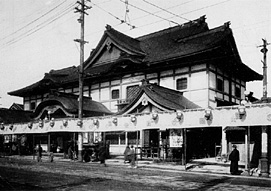Column <Tokyo>
9 Theatrical Performances and Theaters in the Meiji Era (2):
Kabukiza--From the Shintomicho Period to the Kobikicho Period
On August 31, 1888, it was reported that the government had granted a permit to Fukuchi Ochi (Genichiro) and others to establish a "new improved theater" at 3-chome, Kobikicho, Kyobashi-ku (Kyobashi Ward) (present Chuo-ku Ginza). The plan attracted a great deal of attention and in the September 18 edition of The Daily Yomiuri it was revealed that the theater would be named "Kabuza." However, the theater was eventually called "Kabukiza" for some reason, but perhaps not because "the theater should not be named Kabuza to avoid employing ham actors." (In Japanese, kabu or daikon means radish and ham actors are referred to as daikon yakusha.) (Ref. Lamp no Shitanite by Okamoto Kido.)
For Morita Kanya, the manager of Shintomiza, the news that a large theater would open nearby came as a great shock. However, the "Bismarck of the theater world, " as Morita was known, soon devised a countermeasure. According to a Daily Yomiuri article dated September 19, the day after the Kabuza article was published, the four existing theaters--Shintomiza, Ichimuraza, Nakamuraza, and Chitoseza--reached an agreement to cooperate in giving performances. As the first step, the September performance prepared at Shintomiza would be given at Chitoseza, and the three famous actors--Ichikawa Danjuro IX, Onoe Kikugoro V and Ichikawa Sadanji I--would play five, five, and seven roles respectively. Furthermore, the four theaters concluded exclusive agreements with each major actor working in Tokyo, including the aforementioned three, restricting their performances to the four theaters for the five years from January 1889.
Kabukiza's Ochi failed in his efforts to persuade Danjuro, Kikugoro, and others to perform at the theater's opening performance in November, and was quoted as saying disappointedly, "All right, then, I myself will perform on the stage, powdering my face." According to Okamoto Kido, many rumors surrounded the new theater, including that plays would not immediately be staged after construction was compete, and "there is no longer monolithic unity among the four theaters, and the actors will eventually go to Kabukiza."
Even the younger Kido reportedly felt sorry for Ochi, worrying what would happen after the theater's construction was complete. At the end of October, however, it was announced that the three famous actors would perform at the first stage of Kabukiza after all. This was made possible thanks to Inoue Kaoru, who mediated a compromise between Chiba Katsugoro, Kabukiza's sponsor, and Morita, in which Chiba paid a total of 20,000 yen toward Shintomiza's maintenance costs as compensation.
The completed Kabukiza had a total stage area of just over 1485 square meters (27 m by 54 m). From the outside, it was a classic Western-style building with paintings of musical instruments adorning the plaster walls. Its outer fence was made of brick. But on the inside, the building had a true Japanese character with high-quality cypress, although a large chandelier hung from the ceiling of the earthen floor. The three-level theater hall featured 225 booths (each could hold four to five people) on the earthen floor, as well as on the raised earthen floor, and the superior uzura space, while the second and third floors each featured 80 booths.
Large enough to accommodate 3,000 to 3,500 people, reports like the following were common: "In the past, Shintomiza in Shintomicho was said to be the largest theater in Tokyo and in Japan, but Kabukiza is much larger and everyone was surprised at this huge theater." (Fuzoku Meiji Tokyo Monogatari, Okamoto Kido et al.)
Subsequently, in March 1890, Danjuro played an once-in-a-lifetime role in Dojoji, and Kikugoro made a speech in English in Fusennori Uwasano Takadono (Sono 1) and (Sono 2) (story about a man named Spenser riding in a balloon) in January 1891. The plays became extremely popular and the theater was often filled to capacity. Meanwhile, Shintomiza scored a big hit with Megumi no Kenka (Kamino Megumi Wago no Torikumi) in March 1890 and Satsukibare Ueno no Asakaze (a play about the Shogitai troop) in May 1890. The two theaters were soon in hot competition, opening plays on the same day and both scrambling to win the services of Nakamura Ganjiro, a rising star from Osaka looking to make it big in Tokyo.
According to Kido, while Shintomiza seemed more popular than Kabukiza it was riddled with debt, leaving Kabukiza the stand-out winner. The theater remained Tokyo's most popular until Teikoku Gekijo (Imperial Theater) was opened in 1911.
Reference
- The Daily YomiuriÅyYB-41Åz
- Ihara Toshio, Kabukinenpyo, Iwanami Shoten, 1962 Åy774.032-I157k-KÅz
- Ueda Bin, "Kokuristugekijo no Hanashi" Bungei Kowa, Kanao Bunendo, 1907 Åy74-360Åz
- Okamoto Kido, Lamp no Shitanite (Iwanami Bunko), Iwanami Shoten, 1993 ÅyKD487-E43Åz
- Okamoto Kido, Yamada Hajime (ed.), Fuzoku Meiji Tokyo Monogatari (Kawade Bunko), Kawade Shobo Shinsha, 1987 ÅyKH465-E2Åz
- Kaburaki Kiyotaka, Yamada Hajime (ed.), Meiji no Tokyo (Iwanami Bunko), Iwanami Shoten, 1989 ÅyKC19-E9Åz
- Shinoda Kozo, Meiji Hyakuwa, Vol. 2 (Iwanami Bunko), Iwanami Shoten, 1996 ÅyGB415-G7Åz
- Suematsu Kencho, Engeki Kairyo Iken, Bungakusha, 1886 Åy25-286Åz
- Mine Takashi, Teikoku Gekijo Kaimaku (Chuko Shinsho), Chuokoronsha, 1996 ÅyKD11-G10Åz
- Yamamoto Shogetsu, Meiji Seso Hyakuwa(Chuko Bunko), Revised ed. Chuokoronshinsha, 2005 ÅyGB415-H47Åz
- Kabukiza Hyakunenshi Honbunhen, Vol.1, Shochiku, 1993 ÅyKD11-E21Åz
- Engeki Hyakka Daijiten, Heibonsha, 1960-62 Åy770.33-E742-WÅz
- Kokushi Daijiten, Yoshikawa Kobunkan, 1979-97 ÅyGB8-60Åz
